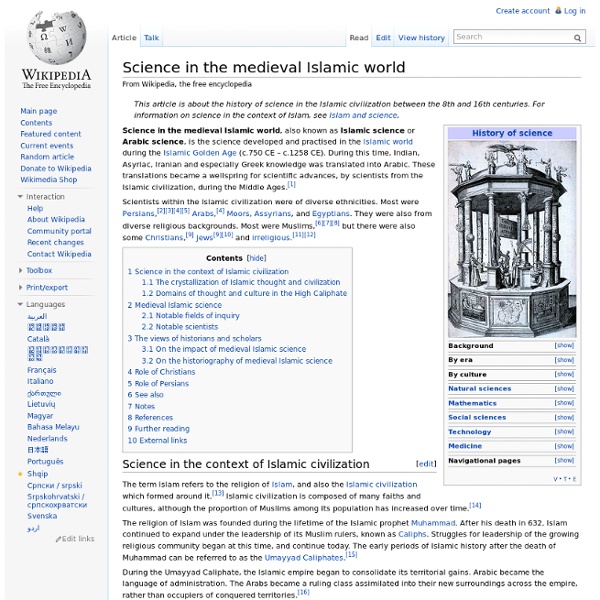Abbasid Caliphate
The Abbasid Caliphate (Arabic: الخلافة العباسية / ALA-LC: al-Khilāfah al-‘Abbāsīyyah), was the third of the Islamic caliphates to succeed the Prophet Muhammad. The Abbasid dynasty descended from the Prophet's youngest uncle, Abbas ibn Abd al-Muttalib (566–653 CE). They ruled as caliphs from their capital in Baghdad, in modern Iraq, after taking over authority of the Muslim empire from the Umayyads in 750 CE (132 AH). The Abbasid caliphate first centered their government in Kufa, but in 762 the caliph Al-Mansur founded the city of Baghdad, north of the Persian capital city of Ctesiphon. Rise[edit] The Abbasid caliphs were Arabs descended from Abbas ibn Abd al-Muttalib, one of the youngest uncles of Muhammad and of the same Banu Hashim clan. Coin of the Abbasids, Baghdad, Iraq, 765. The Abbasids also distinguished themselves from the Umayyads by attacking their moral character and administration in general. Power[edit] These fissures in their support led to immediate problems. Science[edit]
House of Wisdom
This article is about the medieval Abbasid Library, Baghdad. For the ancient Fatimid university see Dar al-Hikmah. Scholars at an Abbasid library. Maqamat of al-Hariri Illustration by Yahyá al-Wasiti, Baghdad 1237 The House of Wisdom (Arabic: بيت الحكمة; Bayt al-Hikma) was a library, translation institute and academy established in Abbasid-era Baghdad, Iraq.[1] It is considered to have been a major intellectual hub during the Islamic Golden Age. During the reign of al-Ma'mun, astronomical observatories were set up, and the House was an unrivaled center for the study of humanities and for science in medieval Islam, including mathematics, astronomy, medicine, alchemy and chemistry, zoology and geography and cartography. History[edit] Foundation and origins[edit] The earliest scientific manuscripts originated in the Abbasid Era. In the Abbasid Empire, many foreign works were translated into Arabic from Greek, Chinese, Sanskrit, Persian and Syriac. Under Al-Ma'mun[edit] Main activities[edit]
Harun al-Rashid
Harun al-Rashid ( Arabic : هارون الرشيد }; Hārūn ar-Rashīd ; English: Aaron the Upright, Aaron the Just , or Aaron the Rightly Guided ) (17 March 763 or February 766 – 24 March 809) was the fifth Arab Abbasid Caliph . His rule encompassed modern Iraq . His actual birth date is debated, and various sources give dates from 763 to 766. He ruled from 786 to 809, and his time was marked by scientific , cultural and religious prosperity. Art and music also flourished significantly during his reign. Since Harun was intellectually, politically and militarily resourceful, his life and the court over which he held sway have been the subject of many tales: some are claimed to be factual but most are believed to be fictitious. The family of Barmakids which played a deciding role in establishing the Abbasid Caliphate declined gradually during his rule. His Life [ edit ] Hārūn was born in Rey . Hārūn became caliph when he was in his early twenties. Anecdotes [ edit ] One day Haroun Al-Raschid read O.
Islamic Golden Age
Causes[edit] With a new, easier writing system and the introduction of paper, information was democratized to the extent that, probably for the first time in history, it became possible to make a living from simply writing and selling books.[4] The use of paper spread from China into Muslim regions in the eighth century CE, arriving in Spain (and then the rest of Europe) in the 10th century CE. It was easier to manufacture than parchment, less likely to crack than papyrus, and could absorb ink, making it difficult to erase and ideal for keeping records. Eastern Christian scholars (including ibn Ishaq) were important in preserving ancient Greek texts.[8] During the 4th through the 7th centuries, scholarly work in the Syriac and Greek languages was either newly initiated, or carried on from the Hellenistic period. Philosophy[edit] Arabic philosophic literature was translated into Latin, and Ladino, contributing to the development of modern European philosophy. Science[edit] Physics[edit]
Siege of Baghdad (1258)
Hulagu had begun his campaign in Iran with several offensives against Nizari groups, including the Assassins, whose stronghold of Alamut his forces seized. He then marched on Baghdad, demanding that Al-Musta'sim accede to the terms imposed by Möngke on the Abbasids. Although the Abbasids had failed to prepare for the invasion, the Caliph believed that Baghdad could not fall to invading forces and refused to surrender. Hulagu subsequently besieged the city, which surrendered after 12 days. During the next week, the Mongols sacked Baghdad, committing numerous atrocities and destroying the Abbasids' vast libraries, including the House of Wisdom. The Mongols executed Al-Musta'sim and massacred many residents of the city, which was left greatly depopulated. Baghdad had for centuries been the capital of the Abbasid Caliphate, the third caliphate whose rulers were descendants of Abbas, an uncle of Muhammad. Persian painting (14th century) of Hülegü's army besieging a city.
The Great Caliphs: The Golden Age of the 'Abbasid Empire - Amira K. Bennison



